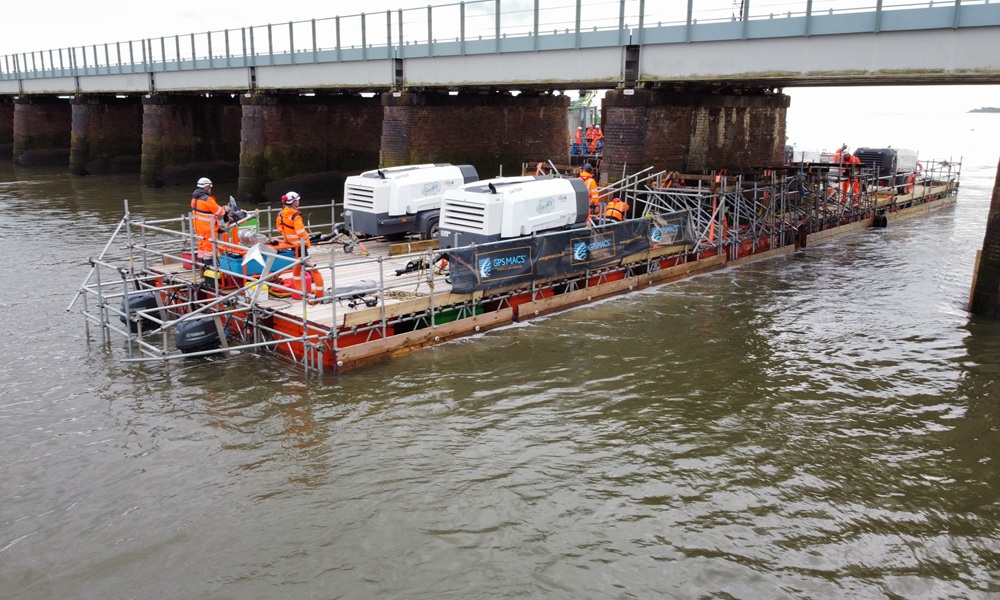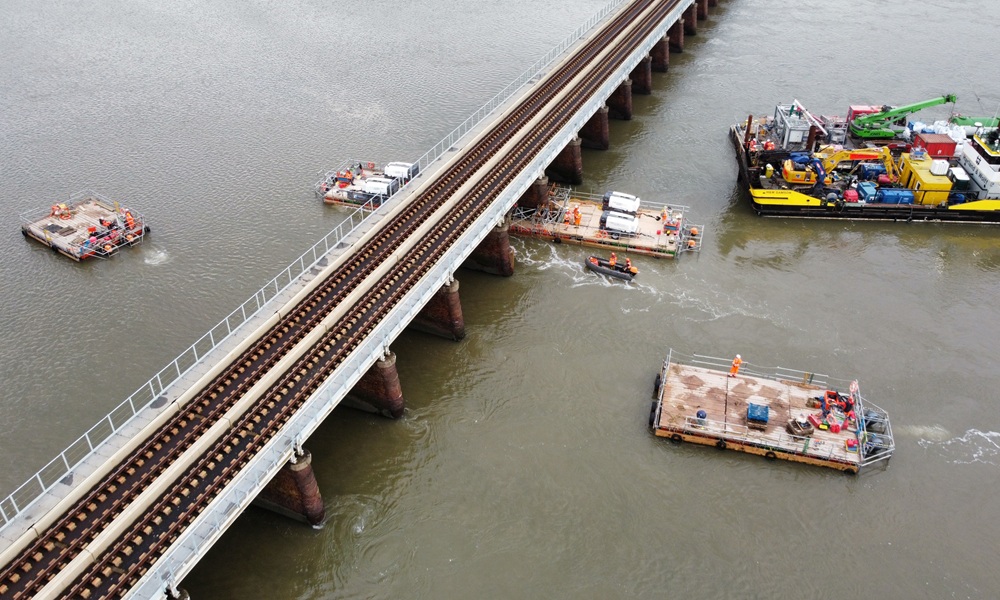Reinforcing the piers that support a major UK rail viaduct spanning a river estuary is no easy task, which is exactly why the specialist marine subcontractor appointed to undertake this project approached Hoist & Winch Ltd for the optimal lifting solution.
The brief provided to Hoist & Winch was for the supply of a turnkey lifting solution comprising two sets of four hoist units suitable for a marine environment. These hoists were to be suspended from temporary scaffold structures fixed to two separate motorised floating pontoons.
As part of an innovative approach to a complex challenge, the hoist-mounted pontoons would serve to locate special horseshoe-shaped reinforcing concrete collars either side of one of the bridge piers at high tide, prior to joining the collar halves together above the water with connection pins. Finally, the collar halves would require lowering to the river estuary bed for permanent fixing to the piers with concrete at low tide, thus providing the necessary reinforcement.
To establish the optimal package of hire equipment, as well as site installation, load testing and additional technical support services, Hoist & Winch consulted extensively with both the motorised pontoon designers and installation personnel responsible for lowering the special concrete collars into position.

After reviewing all the information from project stakeholders, Hoist & Winch subsequently proposed eight JDN top-hook suspension air-powered hoist. Each of these 3t swl (safe working load) hoists featured its own heavy-duty steel lubricator coupled with appropriately sized air supply hoses. The two sets of four hoists units would be operated from their own individually connected, heavy-duty (brass) two-button pendant control.
In order to monitor the load applied to each hoist unit and assist with delivering a balanced collar lowering procedure, Hoist & Winch also provided eight telemetry load cells of bow-shackle design. These load cells served to connect each hoist unit to its local scaffold anchor support position, transmitting individual hoist load data via radio signal to a central laptop display. Armed with this data, the appointed person directing lifting operations could instruct each hoist operator accordingly to ensure the load was evenly distributed between each set of four hoists and that each collar was lowered into position while remaining level.
Prior to commencing the process of installing and lowering the concrete collars, Hoist & Winch carried out the installation of the eight air-powered hoist units. This work included pre-use inspection, static load/deflection testing, and LOLER (Lifting Operations and Lifting Equipment Regulations) certification of the temporary scaffold structure and complete hoisting system.
Hoist & Winch also provided technical consultancy as part of the overall package, delivering guidance on important project areas such as lifting equipment legislation, lifting operation planning and management, and specification and procurement of the portable diesel-powered air compressors to power the hoist units. In addition, the company delivered full handover training for operators.
Both the specialist marine subcontractor and end client were extremely pleased with the final outcome, which saw the successful installation of two sets of trial pier-reinforcing concrete collars to the viaduct as part of a safe and controlled process.
“This specialist project demanded the application of our expertise and experience to ensure a successful conclusion in line with the appropriate safety standards and high performance levels demanded by our client,” says Andy Allen, Director of Hoist & Winch Ltd. “We worked closely with project stakeholders to ensure the delivery of a robustly engineered lifting solution with precision control. Quality solutions and service from Hoist & Winch once again led to a project that concluded with the highest levels of customer satisfaction.”
